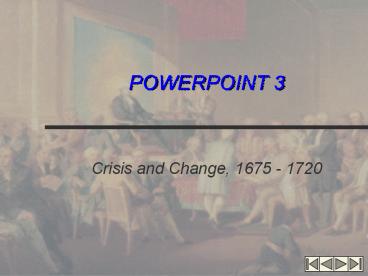Crisis and Change, 1675 - 1720 - PowerPoint PPT Presentation
1 / 14
Title: Crisis and Change, 1675 - 1720
1
POWERPOINT 3
- Crisis and Change, 1675 - 1720
2
Rebellions and War
- Religious unrest increases, especially between
Puritans and Quakers - King Philips War (1671), led by Metacom of the
Wampanoags, leads to loss for Indians - Bacons Rebellion (1675) conflict in Virginia of
elites versus landless challenged colonial
government - Unsuccessful Pueblo revolt (1680) took place
against Spanish in Southwest, killing 400
colonists and 21 priests
3
New England About the Time of King Philips War
4
Bacons Rebellion in Virginia, 1676
5
New Mexico c. 1680
6
William Penns Holy Experiment
- Penn received colony on Delaware River in lieu of
monetary debt owed to his father by Charles II - Penn has grand plans to establish Pennsylvania as
haven for Quakers and place for him to gain
wealth - Set up arbitration panels of natives to resolve
conflicts peacefully - Colony is successful, but not for Penn
- In 1704, three southern counties formed Delaware
7
The Glorious Revolution and Its Aftermath
- Charles II revokes Massachusetts charter and
establishes the hated Dominion of New England - Revolutions occur in 1689, both in England and in
the colonies - James II removed as king, replaced by William and
Mary - Social upheaval contributes to witchcraft
hysteria in Salem, Massachusetts - In Salem, 14 women and 5 men were hanged on
Witches Hill
8
Wars and Rivalry for North America
- English colonists in Carolinas invade Guale and
Florida to gain control of trade centers - French begin exploration and settlement of
Louisiana - In Canada, King Williams War pits the French
and their native allies against the British - In 1713, the Treaty of Utrecht ends Queen Annes
War and cedes control of Nova Scotia,
Newfoundland, and Hudson Bay to British
9
North America in 1700
10
Southeastern North America in Early 18th Century
11
The Entrenchment of Slavery in British America
- Slavery was adopted New World due to
- - British feelings of cultural superiority
- - Native American were difficult to enslave
- and their population was diminished by
- disease
- - Conditions in England less indentured to
America - Middle Passage brought millions of Africans to
the Americas under horrifying conditions - Slavery develops in different ways, based on type
of labor needed
12
Resistance and Rebellion
- Slave rebellions occur rarely, but most
resistance is less aggressive (e.g., feigned
illness, theft, crop destruction) - Slave rebellions were punished with executions
and torture - A few colonists, notably the Quakers, begin to
question morality of slavery
13
Economic Developments in the British Colonies
- Most colonial families lived on farms or
plantations - Northern economies concentrated of fishing and
shipping - Seaports become places of great activity, despite
problems of congestion - Plantations of Chesapeake and South Carolina
become more prosperous, largely due to use of
slave labor - The small slave-owning percent of southern
population dominated the economy and culture
Web
14
Discussion Questions
- What were the causes and impact of King Phillips
War? - Why was William Penns holy experiment able to
deal peacefully with natives? Did relations
remain peaceful? - Examine the reasons for the outbreak of hysteria
over witchcraft in Salem. What finally brought it
to an end? - Describe how slaves resisted the institution
slavery in the New World?






![[Study Tips] APMG International Change Management Certification Exam PowerPoint PPT Presentation](https://s3.amazonaws.com/images.powershow.com/9661122.th0.jpg?_=20210915051)
























